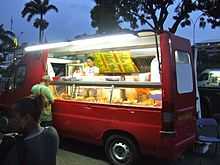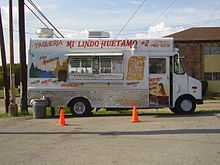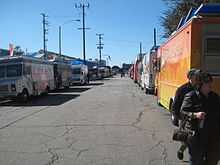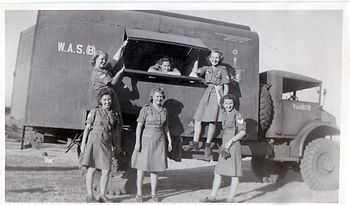Food truck

A food truck is a large vehicle equipped to cook and sell food.[1] Some, including ice cream trucks, sell frozen or prepackaged food; others have on-board kitchens and prepare food from scratch. Sandwiches, hamburgers, french fries, and other regional fast food fare is common. In recent years, associated with the pop-up restaurant phenomenon, food trucks offering gourmet cuisine and a variety of specialties and ethnic menus, have become particularly popular.[2] Food trucks, along with portable food kiosks and food carts, are on the front line of the street food industry that serves an estimated 2.5 billion people every day.[3][4]
Food trucks service events (carnivals, construction sites, sporting events etc.) and places of regular work or study – college campuses, office complexes, industrial parks, auto repair shops, movie sets, farmers' markets, military bases, etc. – where regular meals or snacks are in high demand by potential customers. Food truck dining has caught on in several U.S. and Canadian cities including Toronto, Montreal, Hamilton, Vancouver, Washington, D.C., New York, Austin, Houston, Los Angeles, San Francisco, Seattle, St. Louis, Calgary, Portland and Tampa.[5][6][7][8]
History
In the US, the Texas chuckwagon is a precursor to the American food truck. In the later 1800s, herding cattle from the Southwest to markets in the North and East kept cowhands on the trail for months at a time.[9] In 1866, the "father of the Texas Panhandle," Charles Goodnight,[10] a Texas cattle rancher, fitted a sturdy old United States Army wagon with interior shelving and drawers, and stocked it with kitchenware, food and medical supplies. Food consisted of dried beans, coffee, cornmeal, greasy cloth-wrapped bacon, salt pork, beef, usually dried or salted or smoked, and other easy to preserve food stuffs. The wagon was also stocked with a water barrel and a sling to kindle wood to heat and cook food.[11][12]
Another early relative of the modern food truck is the lunch wagon, as conceived by food vendor Walter Scott in 1872. Scott cut windows in a small covered wagon, parked it in front of a newspaper office in Providence Rhode Island, and sold sandwiches, pies and coffee to pressmen and journalists. By the 1880s, former lunch-counter boy, Thomas H. Buckley, was manufacturing lunch wagons in Worcester, Massachusetts. He introduced various models, like the Owl and the White House Cafe, with features that included sinks, refrigerators and cooking stoves, also colored windows and other ornamentation.[13]
Later versions of the food truck were mobile canteens, which were created in the late 1950s. These mobile canteens were authorized by the U.S. Army and operated on stateside army bases.[14]
Mobile food trucks, or "roach coaches," have been around for years, serving construction sites, factories, and other blue-collar locations.[15] In big cities of the U.S. the food truck traditionally provided a means for the on-the-go person to grab a quick bite at a low cost. Food trucks are not only sought out for their affordability but as well for their nostalgia; and their popularity continues to rise.[16]
The gourmet food truck
In recent years, the food truck resurgence was fueled by a combination of post-recessionary factors. Due to an apparent combination of economic and technological factors combined with street food being "hip" or "chic", there has been an increase in the number of food trucks in the United States.[17][18] The construction business was drying up, leading to a surplus of food trucks, and chefs from high-end restaurants were being laid off. For experienced cooks suddenly without work, the food truck seemed a clear choice.[19][17]
A modern-day food truck isn't just an ordinary taco truck one might find at a construction site.[20] These gourmet trucks' menus run the gamut of ethnic and fusion cuisine. Often focusing on limited but creative dishes at reasonable prices, they offer customers a chance to experience food they otherwise may not. Finding a niche seems to be a path to success for most trucks. While one truck may specialize in outlandish burgers, another may serve only lobster rolls. Food trucks are now even Zagat rated.
Chicago long held the distinction of being the only city in the United States that did not allow food trucks to cook on board, which required trucks to prepare food in a commercial condition, then wrap and label the food and load it into a food warmer. In 2012, under pressure from food truck owners and supporters, including the University of Chicago Law School, regulations were changed to allow on-board cooking, however, controversially, food trucks are required to park 200 feet away from any restaurant, which virtually eliminates busy downtown locations.[21][22][23]
Once more commonplace in the big cities of the eastern and western United States, food trucks recently have evolved to be found in both urban and rural areas of the U.S. Food trucks are also being hired for special events, such as weddings, school dances, birthday parties, retirement parties, and such public gatherings as art festivals and movie nights.
Food truck franchises began to form, catering to the public who were searching for delicious gourmet treats. Gourmet Streets, one of the most respected food truck franchises in America, became a huge sensation as a result of this gourmet revolution.[24] Another truck that found success was the architecturally-inspired gourmet ice cream maker Coolhaus.[25] With inventive flavors such as Whiskey Lucky Charms and Chocolate Chipotle BBQ with Jack Daniel's,[26][27] it grew from a single truck in 2009 to 11 trucks and carts, 2 storefronts, and over 2,500 retail partner stores by September 2014.[25][28]
Food truck rallies are also growing in popularity across the United States. These festivals are gatherings in which people can find their favorite trucks all in one place and as well provide a means for a variety of diverse cultures to come together and find a common ground over a love for food.[2][8][29] On August 31, 2013, Tampa hosted the world's largest food truck rally with 99 trucks attending.[30] Additionally, the popularity of food trucks is leading to the creation of associations that protect and support their business rights, such as the Philadelphia Mobile Food Association.[31]
Tracking food trucks has become much less difficult. With the help of social media like Facebook and Twitter, a person can find where their favorite gourmet truck will be at any moment and get up-to-the-minute updates on specials, new menu items and location changes.[32] In fact, it could be argued that these social media outlets were the biggest contributing factor to the success of the gourmet food truck.[33] In addition to social media, there are a number of food truck tracking programs for smartphones. Some cover specific geographical regions, and others work everywhere.
In 2009, New York magazine noted that the food truck had "largely transcended its roach-coach classification and is now a respectable venue for aspiring chefs to launch careers."[15]
Business and economics
Food trucks are subject to the same range of concerns as other foodservice businesses. They generally require a fixed address to accept delivery of supplies. A commercial kitchen may be needed for food prep. There are a variety of permits to obtain, and a health code to observe. Labor and fuel costs are a significant part of the overhead.[34][35]
Legal definitions and requirements for food trucks vary widely by country and locality. For example, in Toronto, Canada, some of the requirements include business and liability insurance, a Commercial Vehicle Operator’s Registration for the truck, permits for each municipality being operated in (downtown, various suburbs), a food handler certificate, appropriate driver's licenses for drivers, assistant's licenses for assistants, and a health inspection.[36]
As the rising number and popularity of food trucks push them into the food mainstream, region by region, problems with local legislators and police reacting to new situations, and brick-and-mortar restaurants fearing competition, have to be worked through, in some cases creating significant business uncertainty.[37][38][39]
Around the world


Asia
In Asia, the cuisine offered by food trucks requires simple skills, basic facilities and a relatively small amount of capital. They are plentiful, with large potential for income and often a very large sector for employment. Individuals facing difficulty finding work in formal sectors, will often venture into this industry, as it allows entire families to involve themselves in the preparing and cooking of foods sold to the public. The appeal involved in sustaining a food truck lie not only in the low capital requirement, but also in the flexibility of hours, with minimal constraints to locale. Street foods predominantly reflect local culture and flavor. Food trucks appeal to consumers in that they are often an inexpensive means of attaining quick meals. Location and word of mouth promotion has been credited for their widening success.[40]
Australia
Food trucks are available across Australia, and are covered as a popular trend in the media.[41] An Australian national online directory, Where The Truck At, lists some 170 food trucks.[42]
Belgium
Potato chip ("french" fries) trucks have been a staple of the Belgian country-side for ages.[43]
Canada
In Canada, food trucks, also commonly known as cantines (French for cafeteria) in Quebec, are present across the country, serving a wide variety of cuisines, including anything from grilled cheese sandwiches to Mexican.[44] In 2013, Vancouver-based food truck, Vij’s Railway Express, serving fresh Indian cuisine, won the People’s Choice award for Canada’s best new restaurant of the year, in national airline Air Canada’s enRoute Magazine poll, facing off in the finals against 34 conventional restaurants.[45]
France
Although food trucks are common at outdoor markets, American-style trucks selling restaurant-quality food first appeared in Paris in 2012. Their owners needed to obtain permission from four separate government agencies, including the Prefecture of Police, but the trucks' offerings—including tacos and hamburgers—have reportedly been very popular.[46]
Mexico
Although street food in Mexico is illegal and unregulated, food trucks are becoming increasingly popular as of 2013 and owners have created an association to pursue the professionalization and expansion of this commercial sector. In addition to the food trucks catering on the streets, there are regular bazaars organized to introduce their products to the consumers.[47]
United Kingdom

With the advent of motorised transport during World War II, food trucks came into common use. Mobile canteens were used in almost all theatres of war to boost morale and provide food as a result of the successful tea lady experiment.[48]
Food trucks today are known as snack vans and can be found on nearly all major trunk roads at the side of the road or in areas that have a large pedestrian population, such as at village fetes or town centers. These vans can specialise in a myriad of different food types, such as donuts, hamburgers, chili and chips, as well as ethnic food. Some people prefer to stop at snack vans when travelling, due to the low price, rather than stop at a motorway service station where prices can be extremely high.[49]
In popular culture
- In the United States, the food truck phenomenon can be seen regularly on national food television[50][51] Both The Great Food Truck Race (a reality series on the Food Network) and Eat St. (broadcast on the sister station, Cooking Channel), feature food trucks and mobile food carts from all over the US.[52][53][54] The Food Network show Kid in a Candy Store also visited food trucks, looking behind the scenes of gourmet dessert truck Coolhaus to show Balsamic Fig & Mascarpone ice cream in the making.[55]
- On Canada's Food Network, Food Truck Face Off, four teams battle for the grand prize, use of a customized food truck for one year.[56]
- In the 2014 American comedy-drama, Chef, a high-end chef has a kitchen meltdown and rediscovers his passion for cooking while driving and operating a simple food truck across America.
- In the "Food Fight" episode of the TV series, The Glades (Season 3), the plot revolves around restaurants trying to eliminate food truck competition.
List of food trucks
See also
References
- ↑ "food truck". Oxford Dictionaries. Retrieved 12 December 2014.
- ↑ 2.0 2.1 Lempert, Phil (25 October 2010). "Evolution: The Time for Food Trucks Has Arrived!". Supermarket News. Retrieved 21 February 2015.
- ↑ De Cássia Vieira Cardoso,, Ryzia; Michèle Companion, Stefano Roberto Marras (editors) (2014). Street Food: Culture, Economy, Health and Governance. Routledge. p. 256. ISBN 9781138023680.
- ↑ "Spotlight: School Children, Street Food and Micronutrient Deficiencies in Tanzania". Rome, Italy: Food and Agriculture Organization of the United Nations. February 2007. Retrieved 2008-02-20.
- ↑ Reiley, Laura (2011-08-30). "Tampa food truck rally features cheap meals on wheels". Tampa Bay Times. Retrieved 2014-10-31.
- ↑ Jodie Tillman Food trucks roll more variety into downtown Tampa lunch scene November 3, 2011 Tampa Bay Times
- ↑ Shelley Rossetter (2011-10-22). "Second Tampa food truck rally draws thousands". Tampa Bay Times. Retrieved 2013-09-16.
- ↑ 8.0 8.1 "Food Informants: A Week In The Life Of Off The Grid Founder And Owner Matt Cohen". Huffington Post. 2012-08-09. Retrieved 2014-10-31.
- ↑ Thompson, Bill. "American Chuck Wagon Association". Retrieved 2014-10-30.
- ↑ In the Driftway. (1928). [Article]. Nation, 126(3281), 589-590.
- ↑ Sharpe, P. (1996). Camping it up. [Article]. Texas Monthly, 24(9), 92.
- ↑ Butler, Stephanie (August 8, 2014). "From Chuck Wagons to Pushcarts: The History of the Food Truck". HISTORY.com (A&E Television Networks). Retrieved 13 December 2014.
- ↑ Engber, Daniel (May 2, 2014). "Who Made That Food Truck?". New York Times'. Retrieved 13 December 2014.
- ↑ "1957". Redstone.army.mil. Retrieved 2010-01-25.
- ↑ 15.0 15.1 Urstadt, Bryant (23 September 2009). "Intentionally Temporary". New York Magazine. Retrieved 18 February 2015.
- ↑ "Study identifies factors that contribute to food trucks' fast spread". Michigan News. Retrieved 26 February 2015.
- ↑ 17.0 17.1 Buck, Stephanie (2011-08-04). "The Rise of the Social Food Truck [Infographic]". Mashable.com. Retrieved 2014-10-31.
- ↑ Ryssdal, Kai, Food Truck Nation, American Public Media, Friday, July 30, 2010. Retrieved: September 3, 2011.
- ↑ Belluz, J. (2010). Construction guys never ate like this. Maclean's, 123(38), 89.
- ↑ Olivia BarkerUSA, T. (n.d). A foodie-fueled trend takes its act on the road. USA Today.
- ↑ Eng, Monica (January 31, 2013). "First Chicago food truck gets onboard cooking license". Chicago Tribune. Retrieved 22 February 2015.
- ↑ Heagney, Meredith (April 26, 2012). "Food Trucks and Freedom: Law School Hosts Symposium on Mobile Food Laws in Chicago". University of Chicago Law School. Retrieved 22 February 2015.
- ↑ Linnekin, Baylen (July 28, 2012). "Chicago's Disgusting New Food Truck Regulations". Reason Magazine. Retrieved 22 February 2015.
- ↑ Fasman, J. (2010). Trucking delicious. [Article]. Economist, 41-41.
- ↑ 25.0 25.1 Peterson-Withorn, Chase (2014-09-07). "Dessert Startup Founder Looks To Architecture For Inspiration". Forbes. Retrieved 2014-10-30.
- ↑ Mullins, Carrie Vasios (2013-06-11). "We Try All the New Pre-Packaged Ice Cream Sandwiches from Coolhaus". Serious Eats. Retrieved 2014-10-30.
- ↑ Mordy (n.d.). "Coolhaus Ice Cream". Atlas Obscura. Retrieved 2014-10-30.
- ↑ "About Coolhaus". Coolhaus official site. n.d. Retrieved 2014-10-30.
- ↑ Samuelsson, Marcus, , Mobile Food News.com, June 28, 2011. Retrieved: September 6, 2011.
- ↑ "World's largest food truck rally descends on Tampa". Bay News 9. 2013-08-31. Retrieved 2013-09-16.
- ↑ "Street food cards and trucks have grown in stature". Metro. 2012-03-18. Retrieved 2013-10-24.
- ↑ Caldwell, A. (2011). Will tweet for food. The impact of twitter and New York City food trucks, online, offline, and inline. Appetite, 56(2), 522-522.
- ↑ Bly, Laura. Travel by twitter. USA Today.
- ↑ Bowling, Danielle (23 August 2012). "The business of street food". Hospitality Magazine. Retrieved 13 December 2014.
- ↑ Bellow , Lily; Jackeline Pou (October 15, 2010). "Starting your own food truck". PBS. Retrieved 21 February 2015.
- ↑ "Food Truck FAQs". Toronto Food Trucks (Freshdaily Inc.). Retrieved 13 December 2014.
- ↑ Needleman, Sarah E. (9 Aug 2012). "Street Fight: Food Trucks vs. Restaurants". Wall Street Journal. Retrieved 21 February 2015.
- ↑ Shannon, Lauren (3 Jun 2013). "Great eats on the go". JapanToday. Retrieved 13 December 2014.
- ↑ Gowins, Hilary (26 July 2014). "Three Cities Show How Food Trucks Live and Die on Political Whim". Huffington Post. Retrieved 14 December 2014.
- ↑ Winarno,F.G. & Allain, A. Street foods in developing countries: lessons from Asia. FAO. Retrieved September 7, 2011.
- ↑ Grey, Tim (21 January 2014). "Meals on wheels: Australia’s best food trucks". The New Daily. Retrieved 19 February 2015.
- ↑ "Where The Truck At". Retrieved 19 February 2015.
- ↑ fr:Friterie
- ↑ "food trucks in Canada". Google. Retrieved 12 December 2014.
- ↑ Baker, Paula (October 24, 2013). "Food truck takes top people’s choice ‘restaurant’ honours; Pidgin ranks in top 10". Global News. Retrieved 12 December 2014.
- ↑ Moskin, Julia (2012-06-04). "Food Trucks in Paris? U.S. Cuisine Finds Open Minds, and Mouths". The New York Times. pp. A1. Retrieved June 4, 2012.
- ↑ "Asociación Mexicana de Food Trucks". Time Out México. 2013-09-03.
- ↑ "Your Mobile Canteen in Action". Imperial War Museum. Retrieved 2010-07-25.
- ↑ "Snack vans: food on the go - in pictures". The Guardian. 26 September 2013. Retrieved 12 December 2014.
- ↑ Gold, Jonathan (March 2012). "How America Became a Food Truck Nation". Smithsonian Magazine (Los Angeles, CA). Retrieved 2014-10-31.
- ↑ Coulton, A., Hamm, L., Zuckerman, S., Alexander, R., Garcia, J., McNeil, L., . . . Vallancourt, J. (2010). Food Truck Nation. [Article]. People, 74(5), 79-79.
- ↑ Weber, David (2012-04-13). "Startup Lessons from the Food Truck Revolution". Fast Company. Retrieved 2014-10-31.
- ↑ "The Great Food Truck Race, hosted by Tyler Florence". Foodnetwork.com. 2013-06-27. Retrieved 2013-09-16.
- ↑ "Eat Street : Cooking Channel". Cookingchanneltv.com. 2011-02-24. Retrieved 2013-09-16.
- ↑ Adam, Gertler. "Blissfully Sweet (KR0106)". Kid in a Candy Store. Season 1. Episode 6. Available on YouTube. Food Network. Retrieved 2014-10-27.
- ↑ "Food Truck Face Off". Food Network (Shaw Media). Retrieved 12 December 2014.
External links
-
 Media related to Food trucks at Wikimedia Commons
Media related to Food trucks at Wikimedia Commons
| ||||||||||||||||||
| ||||||||||